The UK is home to an impressive diversity of birds of prey, with 16 species present year-round across the country’s varied landscapes. Among them, the common buzzard, Eurasian kestrel, and Eurasian sparrowhawk are the most widespread and familiar, often seen gliding over fields or hunting along woodland edges.
In this guide, we focus on the birds of prey found across the entire United Kingdom, including both Britain and Northern Ireland. We begin with the most common and widespread species before moving on to those that are scarcer or more localized.
The main list highlights the resident raptors that can be seen throughout the year, providing key details on their size, plumage, notable behaviors, and vocalizations to make identification easier in the field. Each entry is supported by photos showing the bird both perched and in flight, along with notes on similar species and how to tell them apart.
We also look beyond the residents to include the raptors that visit the UK seasonally, either to breed in summer or overwinter from northern Europe, as well as a handful of rare vagrants that appear only occasionally or in very small numbers.
Common Buzzard
Buteo buteo
- Identification: Medium-sized, broad-winged raptor with highly variable brown plumage and a short rounded tail.
- Where found: Across the UK – in farmland, woodlands, and open countryside.
- How to spot: Soars in a shallow “V” on thermals, often perches on roadside posts, and calls with a plaintive “kee-yaaa.”
- Region status: Native and resident, widespread year-round.
- Conservation status: Least Concern globally; Green-listed in the UK after recovery from past persecution, with stable or increasing numbers.
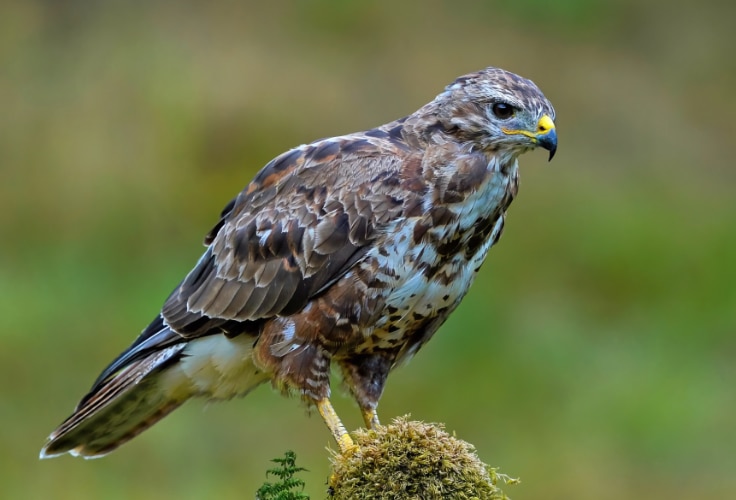
The common buzzard is the UK’s most abundant and widespread bird of prey, now a familiar sight over farmland, woodland edges, and even motorways. In the UK it measures 51-57 centimeters (20.1-22.4 inches) in length, with broad rounded wings and a short, fan-shaped tail that appears compact in flight.
Plumage is extremely variable, ranging from dark chocolate-brown birds to much paler individuals with whitish underparts, but all have dark wing tips, barred flight feathers, and a finely striped tail with a darker terminal band. Adults also show dark trailing edges on the wings, while juveniles tend to be slightly paler overall.
Buzzards are most often seen circling high on thermals, soaring with their broad wings slightly raised in a shallow “V,” unlike the flatter or slightly downcurved wings of a red kite. They give a plaintive mewing “kee-yaaa” call that can resemble a cat, and often perch hunched on roadside posts or trees.

They are resident year-round in the UK and found almost everywhere except the highest peaks and dense urban areas. Breeding usually takes place in mature woodland or on edges of forests, but nests have also been found on cliffs or even old buildings. They feed on rabbits, small mammals, birds, amphibians, large insects, and carrion, readily adapting their diet to what is most abundant locally.
Once heavily persecuted and restricted to western Britain by the mid-20th century, buzzards have made a remarkable recovery. Legal protection, reduced pesticide use, and the resurgence of rabbit populations have all contributed to their return. Today their numbers are stable or even increasing, making them an iconic success story of UK raptor conservation.
Eurasian Kestrel
Falco tinnunculus
- Identification: Slim, medium-small falcon with pointed wings, a long tail, and light-brown plumage with dark spots.
- Where found: Across most of the UK – in open farmland, grassland, heathland, and even towns.
- How to spot: Hovers in place while hunting, tail fanned and head perfectly still, often seen along road verges or perched on posts.
- Region status: Native and resident, widespread year-round.
- Conservation status: Least Concern globally; Amber-listed in the UK after long-term declines linked to farmland changes and prey availability.
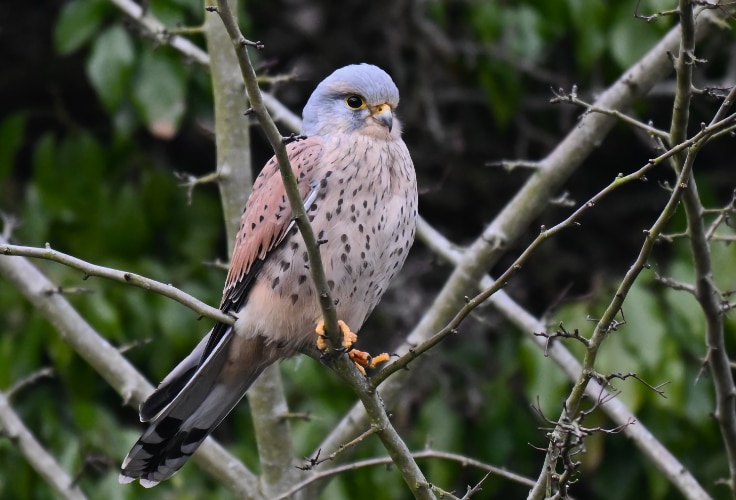
The Eurasian kestrel is the UK’s second most common bird of prey and the most familiar falcon in the region. In the UK, most kestrels measure around 32-35 centimeters (12.6-13.8 inches) in length, with males slightly smaller than females. The long, narrow tail and pointed wings give it a slim, buoyant appearance in flight.
Males have a grey-blue head and tail with a single black band at the tip, while their back and upperwings are chestnut with fine black spots. Females and juveniles are browner overall with darker barring along the back and tail. Both sexes share pale undersides speckled with dark spots, dark ‘tear’ marks beneath the eyes, and bright yellow legs and cere.
Kestrels are best known for their hovering flight, a behavior that earned them the nickname “windhover.” While hovering, they fan their tail and adjust their wings to remain suspended in one spot before suddenly dropping to snatch a vole or small bird. They also hunt from perches such as fence posts, pylons, or lamp posts, scanning open ground for movement.
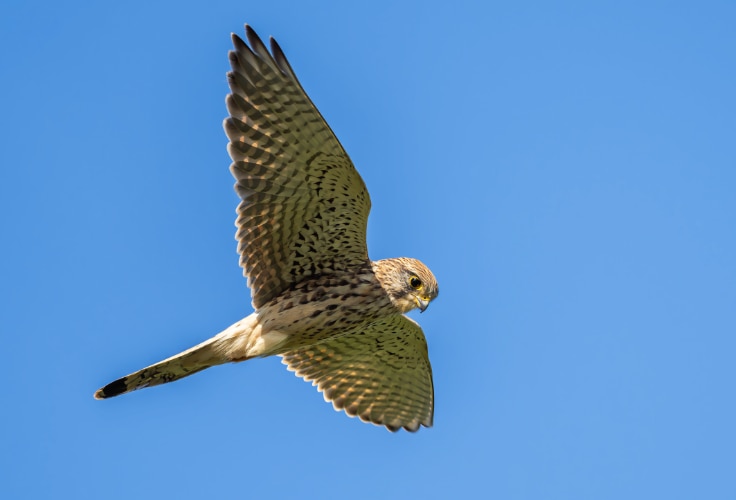
They are found across nearly all of the UK except Shetland and parts of northwest Scotland, favoring open countryside with grassy cover for small mammals. Road verges, farmland, and heathland are typical hunting grounds, though they also adapt well to urban edges and parks. Nesting sites include cliffs, quarries, old trees, and even buildings or nest boxes.
Once recovering from pesticide impacts in the mid-20th century, kestrels have since shown a long-term decline due to agricultural intensification, habitat changes, and possible predation by larger raptors. Despite these pressures, they remain a widespread and well-known falcon, often seen hovering beside roadsides or across farmland.
Eurasian Sparrowhawk
Accipiter nisus
- Identification: Small woodland raptor with short rounded wings, long square-ended tail, and striking yellow eyes.
- Where found: Across the UK – in woodlands, farmland, gardens, and urban green spaces.
- How to spot: Fast low-level ambush flights, a flap-flap-glide pattern, a distinctive T-shaped silhouette in flight, and sudden scattering of small birds.
- Region status: Native and resident, widespread year-round.
- Conservation status: Least Concern globally; Amber-listed in the UK after past pesticide-related declines, now stable or slowly declining in some areas.
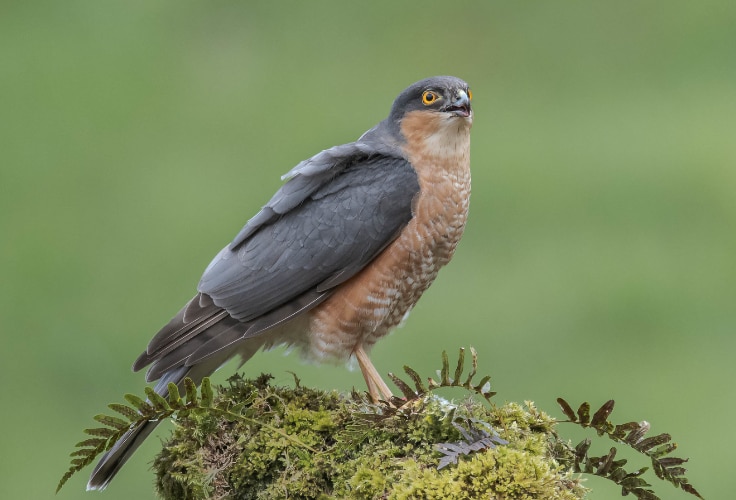
The Eurasian sparrowhawk is the UK’s most widespread true hawk, renowned for its agility and ability to hunt in confined spaces such as woodland edges, hedgerows, and gardens. It is a small bird of prey, measuring 28-40 centimeters (11.0-15.7 inches) in length, with the broad size range explained by females being up to 20-25% larger than males.
Adult males have blue-grey upperparts and rufous-orange barring across the chest and belly, while females and juveniles are brown-grey above with paler underparts barred brown. Females are noticeably bulkier and have a more conspicuous pale eyebrow. Both sexes share bright yellow or orange eyes, a hooked yellow-based bill tipped black, and long yellow legs with fine talons.
Sparrowhawks fly with a characteristic flap-flap-glide pattern, often using buildings or vegetation as cover before darting out in a surprise attack. In flight they show short, rounded wings and a long, narrow, square-ended tail, creating a distinctive T-shaped silhouette. They are often detected by the sudden panic of garden birds or alarm calls before the hawk itself is seen, and plucked feathers in a garden or woodland clearing are a typical sign of a recent kill.

They are found across almost all of the UK except the remote northern Scottish uplands and islands. Sparrowhawks prefer mixed or coniferous woodland for nesting but also exploit suburban gardens, farmland, and hedgerows as hunting grounds. Males mainly catch small birds like finches and sparrows, while the larger females can take thrushes, starlings, and even pigeons.
Once heavily reduced by organochlorine pesticides in the mid-20th century, sparrowhawks have made a strong recovery. Their population stabilized after pesticide bans, but recent moderate declines in parts of England and Scotland suggest new pressures, such as reduced juvenile survival or disease in prey species. Overall, they remain widespread and one of the most commonly seen woodland raptors in Britain.
Red Kite
Milvus milvus
- Identification: Large reddish-brown raptor with long angled wings, pale grey head, and a deeply forked tail.
- Where found: Across Wales, central and eastern England, and parts of Scotland and Northern Ireland – in woodland and open countryside.
- How to spot: Soars with slow, graceful wingbeats, constantly twisting its forked tail to steer; listen for its whistling “weee-oo” call.
- Region status: Native and resident year-round, successfully reintroduced after near-extinction.
- Conservation status: Least Concern globally; Green-listed in the UK thanks to major recovery, though still threatened by illegal poisoning in some areas.
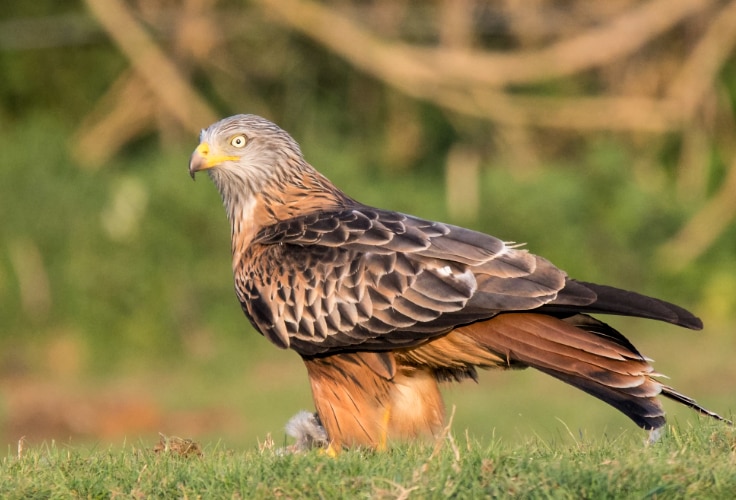
The red kite is one of the UK’s most iconic raptor conservation success stories, saved from near extinction and now returning to skies across much of the country. It is a large, graceful bird of prey measuring 60-72 centimeters (23.6-28.3 inches) in length.
Adults have a pale grey head, reddish-brown body streaked dark, and striking white patches on the underwings contrasting with dark wing tips. Juveniles are paler, with a duller rusty tail and darker head. The long forked tail is the most obvious feature, helping separate it from buzzards, which have shorter, rounded tails.
Red kites soar effortlessly over woodland, farmland, and even towns, with long angled wings and a deeply forked tail that they twist constantly to steer while barely moving their wings. Their flight is slow and buoyant, often accompanied by a high whistling “weee-oo” call.
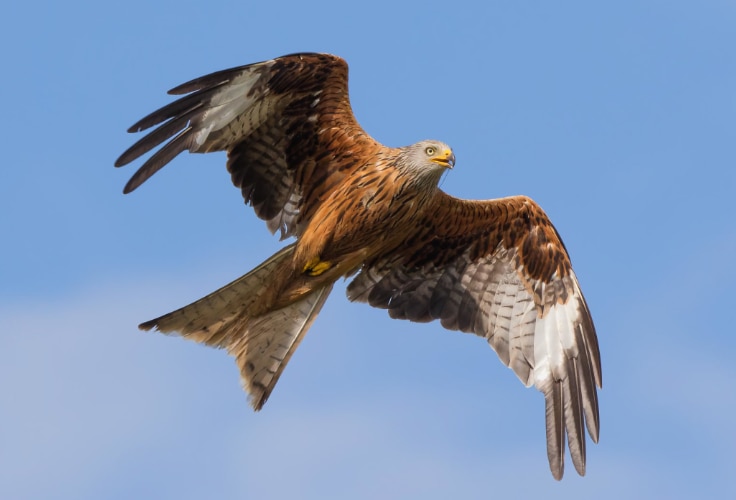
Once confined to a tiny population in mid-Wales due to persecution, they have been successfully reintroduced across England, Scotland, and Northern Ireland. Today they nest in broadleaved woodlands and forage widely over pasture, valleys, and urban edges. They are mostly scavengers, feeding on carrion such as roadkill but will also take small mammals and birds.
Thanks to one of the world’s longest-running protection programs, the red kite has made a dramatic comeback, with thousands now breeding in the UK. However, illegal poisoning and collisions still pose local threats, particularly in parts of northern Scotland. Continued protection and awareness remain key to their long-term recovery.
Peregrine Falcon
Falco peregrinus
- Identification: Large, powerful falcon with pointed wings, a short tail, and a bold dark “moustache” on a white face.
- Where found: Across the UK – in upland crags, sea cliffs, quarries, and now urban areas; winters on estuaries and lowland coasts.
- How to spot: Look for its distinctive triangular wings in fast, agile flight and its high-speed dives when hunting.
- Region status: Native and resident year-round.
- Conservation status: Least Concern globally; Green-listed in the UK, though still persecuted in upland areas and affected by past pesticide use.
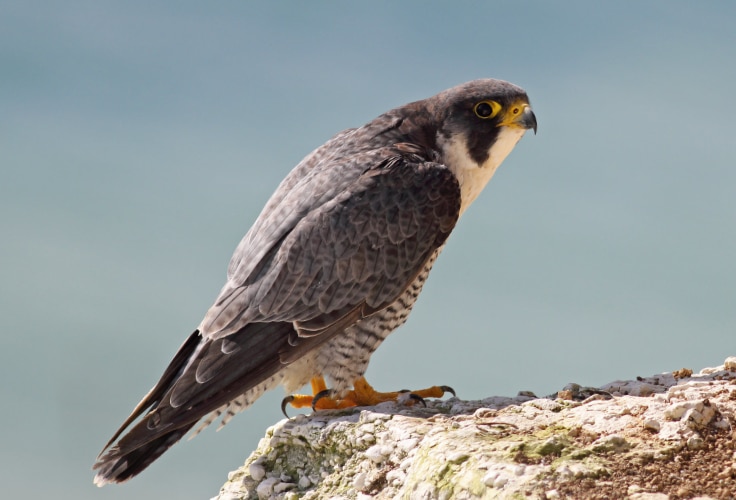
The peregrine falcon is the largest falcon in the UK, measuring 34-58 centimeters (13.4-22.8 inches) in length with a wingspan of up to 1.2 meters (3.9 feet). Built for both power and speed, it has a muscular frame, long pointed wings, and a relatively short square-ended tail, giving it a compact yet aerodynamic shape that makes it the fastest bird in the world.
Adults are blue-grey above with a darker head cap and a striking black moustache mark on a clean white face. The underparts are pale, barred with dark bands across the chest and belly. Females share the same pattern but are much larger and bulkier than the slimmer males, while juveniles are browner above and have buff-streaked underparts rather than neat barring.
Peregrines are most often seen cutting through the sky with strong, direct wingbeats before gliding in wide arcs over cliffs, estuaries, or tall city buildings. When hunting, they climb high above their target before folding their wings tight against the body to execute the dramatic stoop – a breathtaking dive that can exceed 320 km/h (200 mph). Peregrines call most often near the nest, using a sharp “ee-chup” and a rapid “kak-kak-kak” alarm when defending territory.
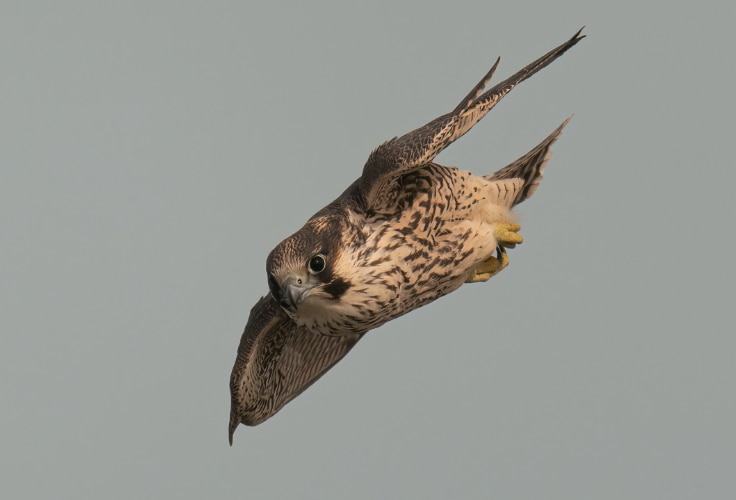
These falcons traditionally nest on high cliff ledges, quarry faces, and rocky sea coasts, with upland areas in Wales, Scotland, and north-west England holding the highest densities. In recent decades they have adapted remarkably well to urban environments, using cathedrals, towers, and even power stations as substitute cliffs.
In winter, upland birds often move to estuaries, marshes, and open coasts where prey is abundant. Prey is mostly medium-sized birds such as pigeons, waders, and ducks, but they have also been seen taking bats on the wing.
After a severe decline in the 1950s and 60s due to pesticide poisoning and persecution, peregrine falcons made a strong recovery following legal protection and the banning of organochlorine chemicals. Today, they have expanded across lowland England and urban sites, though upland populations still face illegal killing linked to game bird management. Continued protection and monitoring have secured their long-term presence, making the peregrine a rare success story among Britain’s birds of prey.
Tawny Owl
Strix aluco
- Identification: Medium-sized stocky owl with a rounded head, dark eyes, and reddish-brown plumage that blends into woodland.
- Where found: Across most of Britain – in woodlands, parks, and large gardens.
- How to spot: Most often heard rather than seen; listen for the iconic male hooting “too-whoo” and female’s sharper “keewik” calls at night.
- Region status: Native and resident year-round.
- Conservation status: Least Concern globally; Amber-listed in the UK due to long-term population concerns linked to habitat changes.
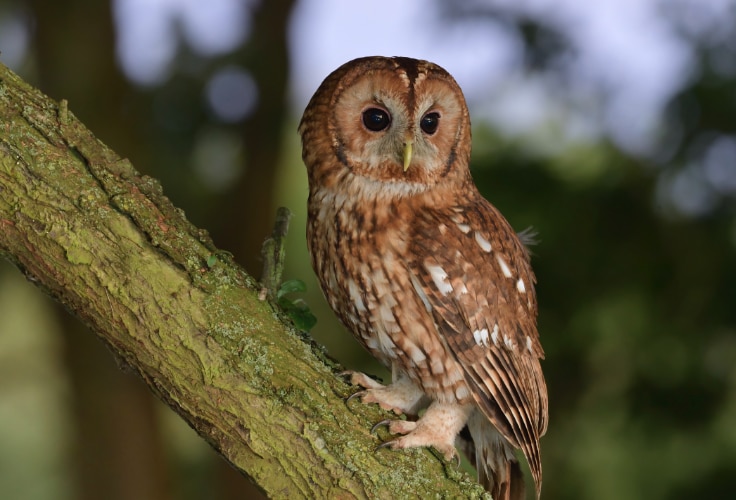
The tawny owl is the most widespread owl in Britain, a nocturnal hunter that has become the familiar voice of the night in woodlands and parks. Across its British range, most measure around 37-39 centimeters (14.6-15.4 inches) in length, with a compact, rounded body and large, forward-facing dark eyes set in a plain facial disc.
Their plumage varies from rich chestnut brown to paler grey-brown, streaked and mottled to blend seamlessly with tree bark. The upperparts are darker with subtle streaks, while the underparts are paler with fine barring. Males and females look alike, though females are slightly larger.
Tawny owls are most easily detected by their calls rather than sightings. At night, males give the classic long, quavering hoot “too-whoo,” while females respond with a sharper “keewik” contact call. These vocal duets are especially common in autumn, when established pairs defend territories from wandering young owls.
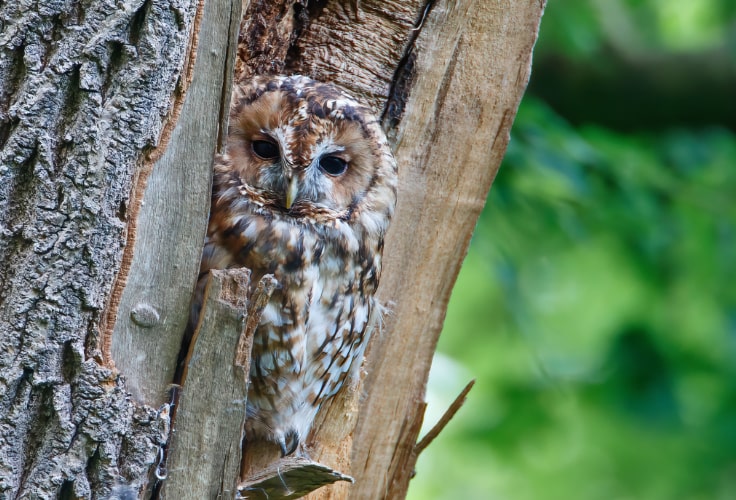
The species is widespread across mainland Britain, found throughout England, Wales, and much of Scotland, but they are absent from Northern Ireland, the Channel Islands, many offshore islands, and treeless upland areas. They live in broadleaved and mixed woodlands, large parks, and even suburban gardens with mature trees.
Pairs stay on the same territory year-round, often using the same tree cavities or nest boxes for many years. They mainly hunt small mammals like mice and voles but will also take small birds, amphibians, and even earthworms on damp nights.
Once stable but now showing a slow, long-term decline, tawny owls face pressures from habitat loss, fragmentation, and possibly reduced prey abundance. Despite this, they remain widespread in Britain, their haunting calls a distinctive part of the night-time soundscape.
Eurasian Goshawk
Astur gentilis
- Identification: Large woodland hawk with broad wings, a long rounded tail, and a fierce look marked by a bold white eyebrow.
- Where found: Wales, southern Scotland, and parts of England – in mature forests, especially large conifer plantations.
- How to spot: Best seen in late winter and early spring during high display flights; flies with deep, deliberate wingbeats and long glides.
- Region status: Native and resident year-round; patchily distributed but slowly increasing.
- Conservation status: Least Concern globally; Green-listed in the UK but still affected by illegal persecution and nest disturbance.

The Eurasian goshawk is a powerful woodland raptor, measuring 46-63 centimeters (18.1-24.8 inches) in length, with a proportionately large head and a long tail that provides exceptional maneuverability among trees. Females are significantly larger than males, accounting for the broad size range and making them some of the most formidable avian predators in British woodlands.
Adults have a steel-grey back, finely barred white underparts, and a distinctive white eyebrow stripe above deep orange or red eyes. Juveniles are browner, with a buff streaked breast rather than barred, and have yellowish eyes that darken with age. Compared to sparrowhawks, they are bulkier, with thicker legs, more rounded tail corners, and deeper, slower wingbeats.
The goshawk can sometimes be spotted circling high above woodland in late winter and early spring, performing its dramatic “sky-dance” courtship display. In normal flight it uses a series of slow, strong wingbeats followed by a long level glide, soaring on flat or slightly raised wings. Despite its size it is remarkably agile, weaving through dense branches to ambush unsuspecting prey. Its vocalizations are mostly heard near nests, where a rapid “kek-kek-kek” call serves as a territorial warning.
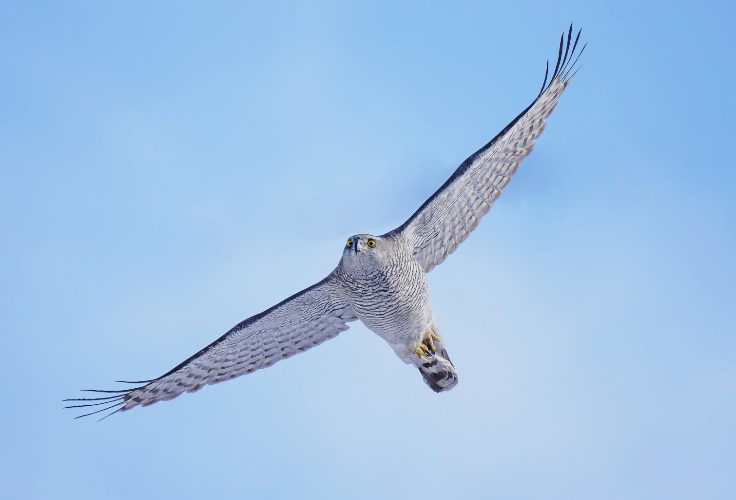
The species inhabits extensive tracts of mature forest, especially large conifer plantations and mixed woodlands interspersed with open glades. In the UK, goshawks are concentrated in southern Scotland, northern England, Wales, and scattered strongholds in southeast England such as the New Forest and Thetford Forest.
They nest high in tall trees and hunt a wide range of prey, from pigeons and corvids to rabbits, squirrels, and occasionally grouse. Most hunting is done from hidden perches, with attacks launched in short, explosive flights.
Once driven to extinction in the 19th century by deforestation and persecution, the current UK population stems from falconry escapes and deliberate releases in the 1960s and 70s. Numbers have grown steadily, but distribution remains patchy and limited by ongoing illegal killing. Continued protection of nesting sites and large forest habitats has allowed goshawks to slowly reclaim their place in Britain’s woodlands.
Merlin
Falco columbarius
- Identification: Tiny, compact falcon with pointed wings and a short square-ended tail; males are blue-grey, females brown.
- Where found: Breeds on upland moorlands of the UK; winters on lowland farmland and coastal marshes.
- How to spot: Flies low with rapid wingbeats and sudden glides, often chasing small birds.
- Region status: Native, resident breeder in uplands, with numbers boosted in winter.
- Conservation status: Least Concern globally; Red-listed in the UK due to historical decline and ongoing habitat pressures.

The merlin is the UK’s smallest native bird of prey, measuring just 24-34 centimeters (9.4-13.4 inches) in length. Despite its tiny size, it is a fierce hunter of small birds, using its short wings and square tail for agile twists and turns during high-speed chases. Females are noticeably larger than males, creating a marked size difference between the sexes.
Adult males have a blue-grey back, rusty underparts streaked dark, and dark outer wings, while females and immatures are mostly brown with paler buff underparts streaked with brown. All have dark eyes, a small black beak with a yellow base, and bright yellow legs. In flight, merlins appear more compact than kestrels, with shorter tails and faster, more purposeful wingbeats.
The merlin often hunts low over moorlands and open ground, hugging the contours of the landscape before surging upward to ambush prey. In winter they can be seen dashing across salt marshes and farmland edges, where they target flocks of small birds. Their wingbeats are quick and fluid, occasionally followed by a brief glide with wings pulled close to the body. Vocalizations are rare outside the breeding season, but near nests they produce a sharp “kek-kek-kek” alarm call.
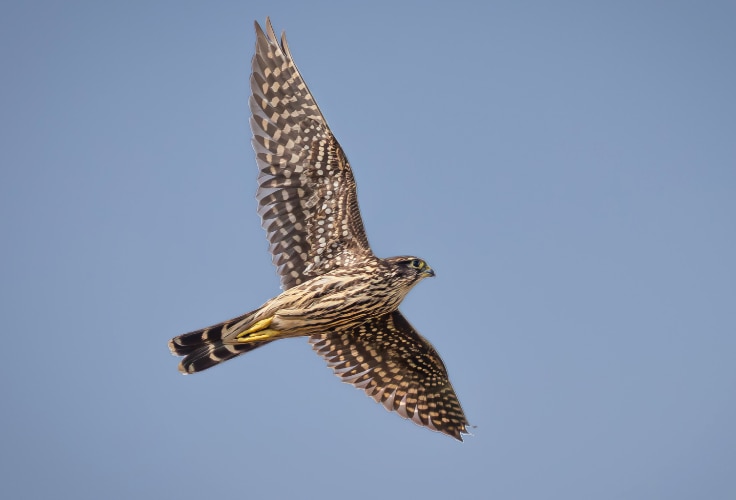
Breeding mainly takes place on heather moorlands and remote uplands, with strongholds in the Scottish Highlands, the Pennines, south-west England, upland Wales, and parts of Northern Ireland. Merlins typically nest in deep heather on the ground but will also use abandoned crow or raptor nests along the edges of moorland and young conifer plantations.
After the breeding season they disperse widely, moving to milder lowland areas, estuaries, and coastal marshes where they hunt flocks of waders and small passerines. In winter, the UK population is joined by migrants from Iceland and northern Europe, greatly increasing their numbers on open farmland, salt marshes, and coastal plains.
Historically, merlins declined due to persecution, habitat loss, and pesticide use, leading to a severe reduction in breeding numbers. Though some recovery followed legal protection and reduced pesticide use, the species remains scarce and vulnerable. Conservation now focuses on maintaining suitable upland breeding habitat and lowland wintering sites, as well as continued monitoring of breeding success and productivity.
Western Barn Owl
Tyto alba
- Identification: Medium-sized owl with a distinctive heart-shaped facial disc, pale golden-buff upperparts, and pure white underparts.
- Where found: Lowland Britain and Northern Ireland, avoiding high-altitude uplands, dense urban centres, and remote northern islands.
- How to spot: Most often seen hunting silently at dusk or dawn, flying low over fields and rough grassland; sometimes perched on posts.
- Region status: Native and resident; widespread year-round.
- Conservation status: Least Concern globally; Green-listed in the UK after significant recovery aided by nest box schemes and habitat restoration.

The western barn owl is one of the most easily recognised owls in the United Kingdom. It is a medium-sized owl, with most UK individuals measuring 33-39 centimeters (13-15.4 inches) in length, and has a rounded head, long legs, and long, broad wings. Its large heart-shaped facial disc frames dark, almost black eyes and helps direct sound to the ears, enhancing its ability to locate prey in low light.
Adults are pale beneath, often pure white, while their upperparts are washed in soft golden-buff tones with varying amounts of grey mottling. Females are typically darker than males and more heavily speckled on the underparts and flanks. Juveniles resemble adults but may appear more strongly marked. In flight, barn owls can sometimes be confused with short-eared owls, but the latter has piercing yellow eyes and more patterned plumage.
Barn owls are most often seen at dusk or dawn, gliding silently just a few metres above grassland or farmland as they listen for small mammals. Hunting is almost completely silent thanks to specialised feathers that muffle flight noise. Calls are rarely heard outside the breeding season, but males give a drawn-out rasping screech near nest sites, and chicks make a hissing or snoring sound to beg for food.

The species favors lowland farmland, open countryside, and grassy field margins where small mammals are abundant, avoiding upland moors, dense urban centres, and the far north and western isles of Scotland. It is widespread across England and Wales, with highest densities in the east and south, more scattered populations in Scotland, and much sparser distribution in Northern Ireland.
Barn owls nest in old barns, hollow trees, church towers, or increasingly in artificial nest boxes provided by conservation projects. Their main prey is field voles, wood mice, and shrews, though they will also take small birds, amphibians, or even bats. British and Irish barn owls remain close to their territories all year, with only young birds dispersing a short distance from their natal sites.
Once much more common, barn owls declined severely during the 20th century due to pesticide poisoning, loss of rough grassland habitat, and collisions with vehicles. Conservation initiatives, including widespread provision of nest boxes, habitat management to support small mammal prey, and milder winters, have supported a strong recovery. Today, they remain a cherished symbol of Britain’s countryside, especially in the east and south where densities are highest.
Long-Eared Owl
Asio otus
- Identification: Medium-sized, slender owl with prominent ear tufts, mottled brown plumage, and striking orange eyes.
- Where found: Scattered across Britain and Northern Ireland – in dense woodland and scrub near open fields.
- How to spot: Best seen in winter roosts or heard on summer nights when young give their “squeaky gate” call.
- Region status: Native and mostly resident, with numbers boosted in winter by migrants from northern Europe.
- Conservation status: Least Concern globally; stable in Ireland but scarce and under-recorded in Britain, facing ongoing habitat loss and disturbance.

The long-eared owl is a secretive, medium-size woodland owl, measuring 35-40 centimeters (13.8-15.7 inches) in length, with a slim build and long wings. Its most distinctive features are the tall ear-like tufts it raises when alarmed, giving it an elongated appearance compared to other owls.
Adults have buff and brown plumage streaked with darker markings, a pale facial disk edged in black, and deep orange eyes. Females tend to be darker and richer in color, while males appear paler overall. Juveniles have a similar face and wings but softer grey-buff bodies.
Long-eared owls are almost entirely nocturnal and rarely seen by day except at communal winter roosts. They fly with long, level glides interspersed with deep, slow wingbeats, and are agile in dense woodland. In spring and summer, males deliver a slow, rhythmic “hoo” call that can carry over a kilometer, while alarmed birds give harsh barking notes. Young owls produce a distinctive “squeaky gate” begging call.
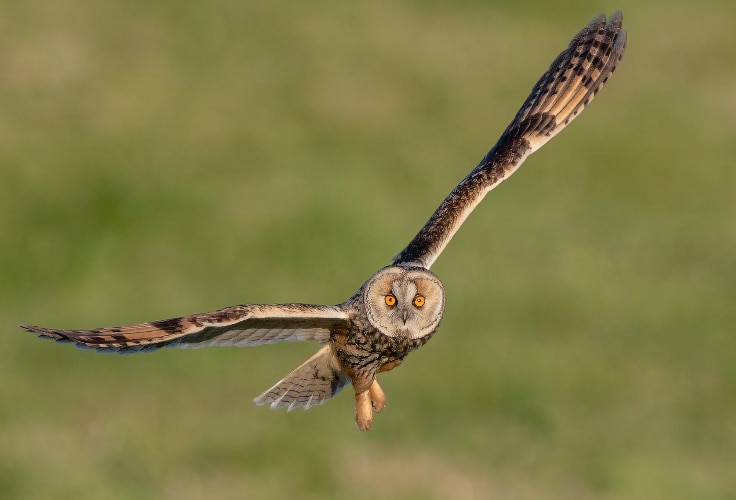
In the UK, they breed in scattered locations across England, Scotland, Wales, and Northern Ireland. They favor dense coniferous or mixed woodland, shelterbelts, and scrub close to open grassland or farmland used for hunting. Northern breeding birds migrate southwards in winter and are joined by variable numbers of visitors from Scandinavia, sometimes gathering in communal roosts.
Long-eared owls don’t build their own nests but instead reuse stick nests built by crows, magpies, or other raptors. Their diet consists mainly of small mammals such as voles and mice, with small birds taken occasionally.
The species is scarce and difficult to census in the UK due to its secretive and nocturnal habits. Although the overall population trend remains uncertain, some regions have seen local declines linked to woodland loss, roost disturbance, and reduced prey availability. Conservation efforts focus on protecting suitable woodland habitats and safeguarding known roosting and nesting sites.
Hen Harrier
Circus cyaneus
- Identification: Slim, medium-sized harrier with long wings, an owl-like face, and a conspicuous white rump.
- Where found: Breeds on upland moorlands of Scotland, Wales, Northern Ireland, and Orkney; winters on lowland farmland, heathland, and coastal marshes.
- How to spot: Look for its buoyant low-level flight with wings held in a shallow “V,” often near moorland or rough grassland.
- Region status: Native but very scarce and localized; highly threatened.
- Conservation status: Least Concern globally; Red-listed in the UK due to illegal persecution and habitat loss linked to driven grouse moor management.

The hen harrier is one of the UK’s most graceful yet most persecuted birds of prey, long associated with the conflict between raptors and driven grouse moors. It is a medium-sized harrier measuring 42-52 centimeters (16.5-20.5 inches) in length, with long, narrow wings, a slim body, a rounded owl-like facial disc, and a distinctive white rump.
Adult males are soft blue-grey above with black wingtips and pale underparts, earning them the nickname “ghost of the moor” for their striking plumage and elusive presence. Females and juveniles, known as “ringtails,” are rich brown with streaked underparts and a clearly barred tail, the white rump flashing prominently in flight. Compared to the larger marsh harrier, hen harriers are slimmer, with more pointed wings and a longer, more elegant tail that enhances their agile flight.
They are most often seen hunting low over moorland, heath, or rough grass, moving smoothly with wings held in a shallow “V” as they search for meadow pipits, voles, and other small prey. In spring, males perform spectacular sky-dances, climbing high before plummeting into twisting dives to impress females. Their calls are soft and infrequent outside breeding, but males give a rapid “che-kuk-kuk-kuk” in display flight, often answered by the female’s higher-pitched reply near the nest.
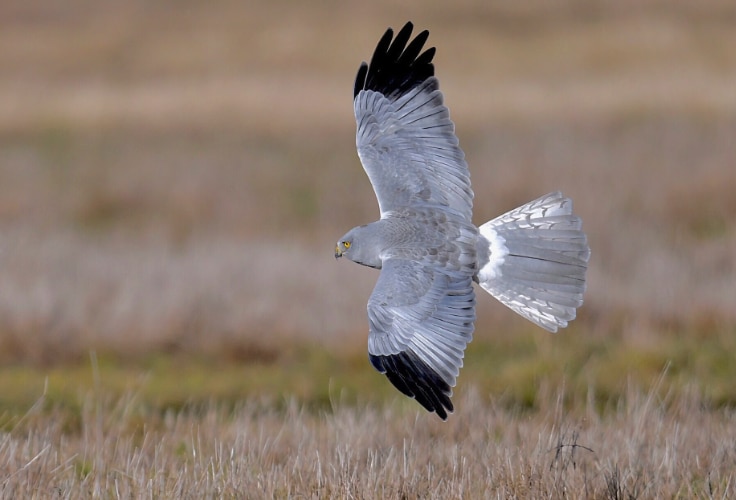
Hen harriers breed in remote upland habitats, nesting on the ground among heather and bog vegetation. They are concentrated in Scotland, Orkney, upland Wales and Northern Ireland, with only a few pairs nesting in northern England. In winter they disperse to lowland farmland, heathland, river valleys, and coastal marshes, sometimes forming communal roosts at traditional sites. Their diet is dominated by voles, small birds, and occasionally larger prey such as grouse or rabbits.
Once widespread, hen harriers suffered severe declines due to habitat change and illegal persecution on driven grouse moors. Numbers in Orkney have increased thanks to suitable foraging habitat, but in England they remain on the brink due to persistent wildlife crime.
Conservation projects focus on nest protection, satellite tracking, and creating habitat mosaics that combine heather moorland with rough grassland. Ending illegal killing remains the single most important step for their recovery, while ongoing efforts aim to resolve the long-standing conflict between raptor conservation and grouse shooting interests.
Short-Eared Owl
Asio flammeus
- Identification: Medium-sized, pale-bellied owl with mottled brown upperparts, yellow eyes framed by dark patches, and very short, almost invisible ear tufts.
- Where found: Breeds on open moorlands and rough grasslands across northern England and Scotland; winter visitors occur more widely, especially along eastern and southern coasts.
- How to spot: Best seen flying low over fields and moorland in a buoyant, moth-like flight during daylight.
- Region status: Native but scarce and nomadic breeder; winter numbers increase with arrivals from Scandinavia and Russia.
- Conservation status: Least Concern globally; Amber-listed in the UK due to major range contraction and sensitivity to habitat change.

The short-eared owl is a medium-sized, slender owl measuring 34-42 centimeters (13.4-16.5 inches) in length. It appears slightly smaller and slimmer than the tawny owl, with long wings and a rounded facial disk.
Adults are mottled brown above with pale underparts streaked on the breast and a contrasting dark facial frame around piercing yellow eyes. Females are generally darker and more richly toned than males, but the difference is subtle. In flight, the pale trailing edge of the wing and dark wrist patches are distinctive. Juveniles are duskier with softer facial markings and browner eyes.
It can be confused with the long-eared owl, but the short-eared has rarely visible ear tufts giving it a smoother head profile, and is distinguished by its yellow eyes framed by darker patches rather than the long-eared’s orange eyes.
This species is more diurnal than most owls and is often seen actively hunting over open country during the day. Its foraging flight is buoyant and moth-like, with slow wingbeats and glides as it moves low over grasslands. When displaying in spring, males perform long looping flights, sometimes lasting an hour, with bursts of rapid wing-clapping and a series of soft hooting calls. Alarmed birds give harsh barks and screeches.
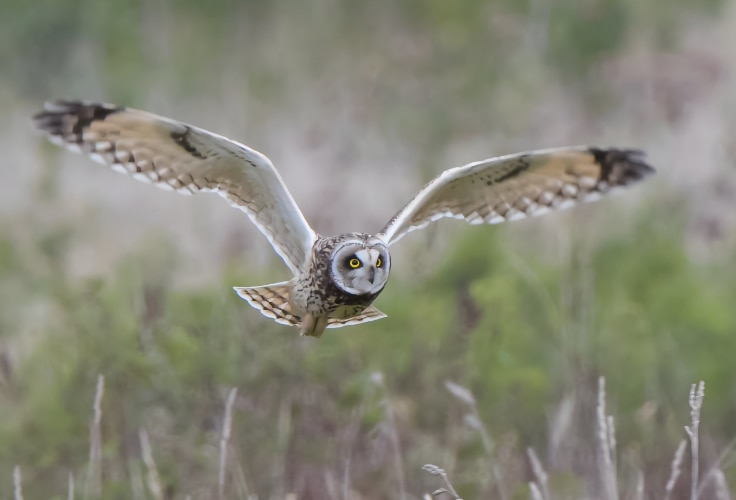
In the UK, short-eared owls breed mainly in northern and upland areas, including heather moorlands, rough grasslands, bogs, and young forestry plantations across Scotland and northern England. They are the only British owl to regularly build their own nest, usually a shallow scrape on the ground lined with grass. Their diet consists almost entirely of small mammals, particularly field voles, which strongly influence breeding success and distribution.
The species is a scarce and nomadic breeder in the UK, with numbers fluctuating greatly depending on prey availability. In autumn and winter, resident birds are joined by large numbers of migrants from Scandinavia, Iceland, and Russia, increasing their presence along the east and south coasts, lowland river valleys, and open downland.
Since the 1960s, their breeding range in Britain has nearly halved, mainly due to habitat loss from afforestation, changes in upland management, and maturing plantations that reduce vole numbers. Conservation efforts focus on protecting moorland and rough grassland habitats essential for both nesting and hunting.
Golden Eagle
Aquila chrysaetos
- Identification: Huge dark-brown eagle with a golden-tinged head and long broad wings ending in distinct fingered tips.
- Where found: Remote moorlands and rugged mountains of the Scottish Highlands, islands, and parts of Northern Ireland.
- How to spot: Soars with slow, deep wingbeats in a slight “V,” often gliding for long distances.
- Region status: Native and resident year-round.
- Conservation status: Least Concern globally; Green-listed in the UK but still threatened locally by illegal persecution linked to game management.

The golden eagle is one of the UK’s largest and most iconic birds of prey, second only in size to the white-tailed eagle. In the UK it measures 75-88 centimeters (29.5-34.6 inches) in length, with a powerful frame, long fan-shaped tail, and a wingspan reaching up to 2.2 meters (7.2 feet).
Adults are dark brown with a golden sheen on the head and nape, which glows in sunlight and gives the species its name. Juveniles are darker, with striking white bases to the tail and pale patches on the underwing that fade gradually with age. Compared to the white-tailed eagle, the golden eagle has a longer, more tapering tail, and slimmer, more elegant wings.
They are best spotted soaring or gliding on thermals over moorlands and ridges, holding their broad wings in a slight “V” with slow, deliberate wingbeats. Golden eagles often hunt by gliding along slopes or soaring over wide areas, using their exceptional eyesight to spot prey. They are mostly silent but may give a high, thin call in flight, particularly around the nest.
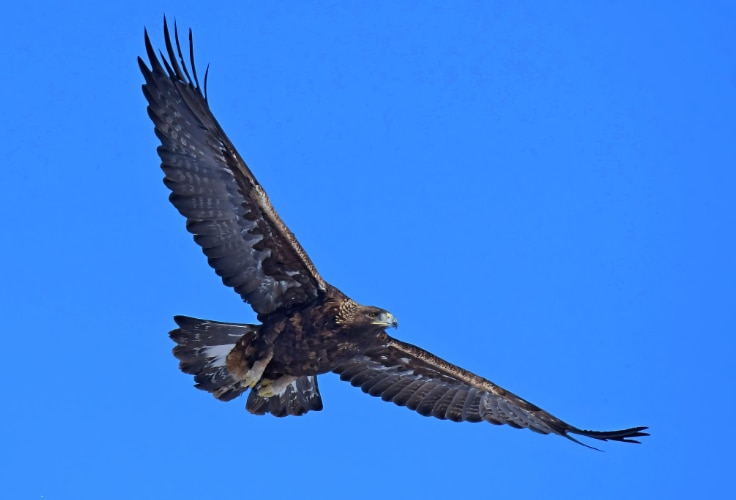
In the UK, they are now confined mainly to the Scottish Highlands, Hebrides, and a few territories in Northern Ireland. Golden eagles favor remote uplands, open moorlands, and rugged mountain slopes with minimal human disturbance. They build large stick nests on cliffs or in tall trees and return to the same traditional sites for generations. Their diet is diverse, from rabbits and mountain hares to birds, carrion, and occasionally small livestock.
Golden eagle numbers remain broadly stable, with a small increase following decades of legal protection and reintroduction efforts in Ireland. However, illegal poisoning and persecution associated with grouse moor management continue to limit populations in some areas. Conservation programs, tighter law enforcement, and public awareness are essential for their long-term survival in the UK.
Western Marsh Harrier
Circus aeruginosus
- Identification: Large harrier, with a heavy build, long tail, and broad wings, females have a pale head and throat.
- Where found: Prefers reedbeds, marshes, and farmland, with strongholds in eastern and south-east England, plus scattered populations elsewhere.
- How to spot: Look for its low, gliding flight with wings held in a shallow “V” over wetlands, often dropping suddenly to snatch prey.
- Region status: Native but rare; mainly a breeding migrant, though increasing numbers now overwinter.
- Conservation status: Least Concern globally; Amber-listed in the UK due to historical declines, though recovering thanks to habitat restoration and reduced persecution.

The western marsh harrier is the largest of the UK’s harriers, measuring 43-56 centimeters (16.9-22 inches) in length, with a wingspan reaching up to 1.45 meters (4.8 feet). It is bulkier than the slimmer hen harrier, with broader wings and a heavier frame, making it more powerful in appearance.
Adult males are brown above with chestnut underparts and striking tri-colored wings: brown near the body, pale grey panels mid-wing, and black wingtips. Females are larger, rich chocolate-brown overall, with a distinctive creamy-yellow crown and throat that make them easy to recognise. Juveniles resemble females but are darker, with fewer pale markings. Both sexes lack the prominent white rump that helps identify hen harriers.
Marsh harriers are most often seen drifting low over wetlands, scanning for prey with slow, methodical passes, showing a long tail and broad, steady wingbeats while holding their wings in a shallow “V” before dropping suddenly into the vegetation. Like hen harriers, males perform a dramatic sky-dance in spring, with steep dives and swoops to attract females, sometimes locking talons in mid-air.
Vocalisations are mostly limited to the breeding season, with males giving a shrill “kweeoo” display call and females responding with a piping whistle during food passes.
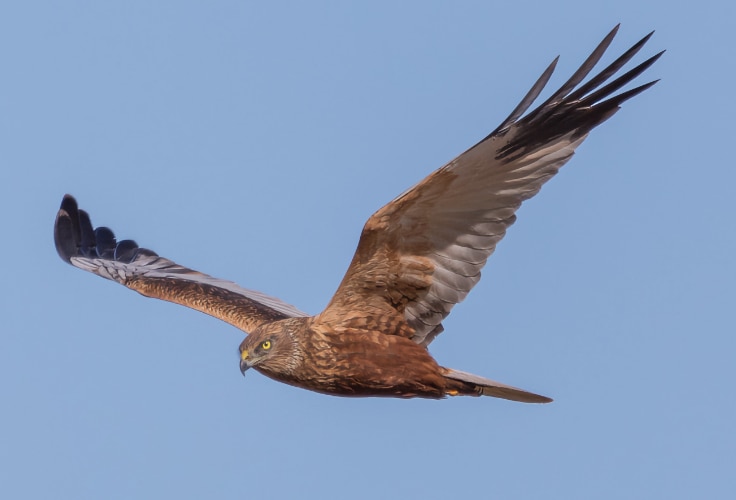
In the UK, marsh harriers are concentrated in East Anglia, Somerset, and the south-east, with smaller breeding populations in north-west England and parts of Wales and Scotland. They favor extensive reedbeds but can also nest in farmland and open countryside. Their diet is varied, taking small birds, chicks, rodents, frogs, and occasionally carrion. Once mainly summer migrants, more birds now remain through winter, roosting communally in reed beds and coastal marshes.
Historically widespread, the marsh harrier was driven to extinction in Britain by persecution in the 19th century, then recolonised in the 20th century only to collapse again to a single breeding pair by 1971. Since then, legal protection, reed bed restoration, and reduced pesticide use have led to a remarkable recovery, with several hundred breeding pairs now established. Although they are no longer as rare as before, their history of decline means they remain threatened and closely monitored.
White-Tailed Eagle
Haliaeetus albicilla
- Identification: Massive, heavy-set eagle with broad rectangular wings, a pale head and neck, and a short wedge-shaped white tail in adults.
- Where found: Coastal regions, sea lochs, islands, and large lakes in Scotland, plus reintroduced populations on the Isle of Wight and south coast.
- How to spot: Soars with huge, flat wings like a “flying barn door,” often near coasts; juveniles are dark with no white tail.
- Region status: Native and resident year-round.
- Conservation status: Least Concern globally; Amber-listed in the UK, recovering but still vulnerable to local persecution and habitat pressures.

The white-tailed eagle is the largest bird of prey in the UK, with a body length of 74-92 centimeters (29.1-36.2 inches) and an immense wingspan of up to 2.6 meters (8.5 feet). Also called the sea eagle, it is an unmistakable giant of coastal and wetland landscapes. In flight it appears broad-winged and rectangular, dwarfing other raptors and gliding effortlessly on flat wings.
Adults are mostly brown with a conspicuously pale head and neck that can appear almost white in older birds, and a bright white wedge-shaped tail. The huge yellow bill is also a key feature. Juveniles are much darker, with dark bills and tails, and gradually develop adult plumage over five to six years. Females are larger than males, but otherwise the sexes look similar.
The white-tailed eagle soars over sea lochs, estuaries, and large inland waters on enormous, almost rectangular wings, earning the nickname “flying barn door.” It dwarfs other raptors in flight, gliding effortlessly on flat wings unlike golden eagles, which hold theirs in a shallow “V.” Their calls are most often heard around the nest and include a high yelping series.
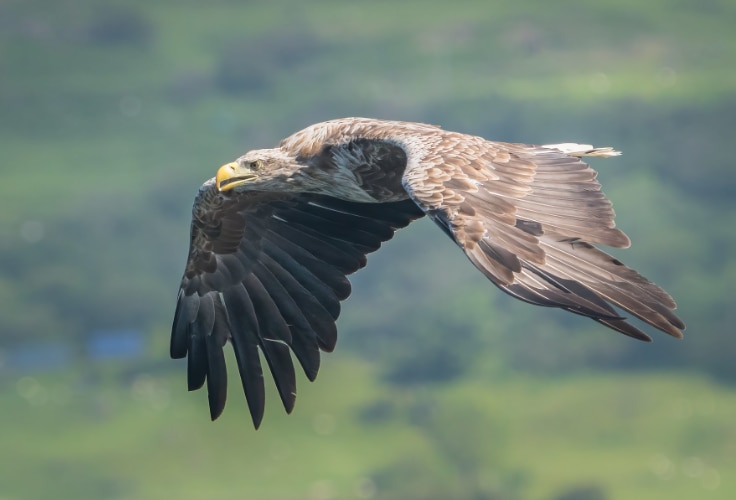
In the UK, white-tailed eagles are most common along the west coast of Scotland, the Hebrides, Mull, and nearby islands, though they have recently been reintroduced to southern England. They favor lowland coasts, rocky islands, and large lakes for feeding, and build enormous stick nests on sea cliffs or in tall trees near water. Their diet is varied, from fish and seabirds to rabbits, hares, and carrion, sometimes even taking waterfowl chicks from colonies.
Once widespread, the species was driven to extinction in Britain by persecution and habitat loss by 1916. Following a landmark reintroduction program on the Isle of Rum in 1975, Scotland now holds over 100 breeding pairs. New releases on the Isle of Wight since 2019 are helping expand the population southward. Despite strong legal protection, illegal killing still occurs in some areas, so continued conservation work remains vital for its full recovery.
Little Owl
Athene noctua
- Identification: Compact, short-tailed owl with grey-brown upperparts heavily spotted white, pale streaked underparts, and piercing yellow eyes beneath strong pale eyebrows.
- Where found: Across lowland England and Wales – in mixed farmland, orchards, and parkland with mature trees and open ground.
- How to spot: Often seen perched on fence posts, telegraph poles, or old trees in daylight, especially early morning and dusk, bobbing its head when alarmed.
- Region status: Introduced from mainland Europe in the 19th century; now a resident species, remaining in the same territories year-round.
- Conservation status: Least Concern globally; UK numbers declining due to habitat change and reduced juvenile survival.
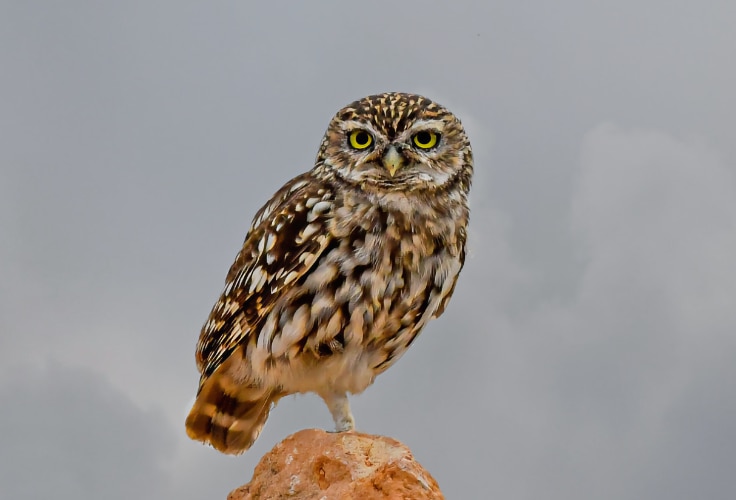
The little owl is the smallest owl in the UK and also the smallest non-native bird of prey, measuring just 21-23 centimeters (8.3-9.1 inches) in length. It has a rounded head without ear tufts, a compact, chunky build, and broad, rounded wings that give a slightly undulating flight with rapid wingbeats. Its pale eyebrows and intense yellow eyes create an unmistakable fierce expression.
Adults are grey-brown above, spotted and flecked with white, with pale underparts densely streaked and splashed with brown. Males and females look alike, while juveniles are paler and more uniformly patterned.
Little owls are frequently active in the daytime, making them easier to spot than most other British owls. They often sit on prominent perches such as posts, branches, or roadside poles, watching for prey. When alarmed, they bob their heads up and down in a characteristic gesture before darting away in a rapid, low flight. Their calls include a shrill yelping alarm, a nasal “gwooooohk” song from males, and softer contact calls between pairs.
They prefer mixed farmland, hedgerows, orchards, and parkland with open ground for hunting and mature trees or old buildings for nesting cavities. In the UK they are most numerous in East Anglia, the Midlands, and central northern England, with fewer populations further west and in coastal Wales. Their diet is varied, consisting mainly of insects, beetles, and other invertebrates, supplemented by small mammals, birds, and occasionally amphibians and reptiles.
Introduced from mainland Europe in the late 1800s, the little owl quickly established itself across much of England and Wales but has been in decline in recent decades. Habitat changes, reduced prey availability, and lower juvenile survival are thought to be the main drivers. Although still fairly widespread, local losses have occurred, and their UK range has contracted slightly. Maintaining mixed farmland with rough grass margins and veteran trees is key to supporting their populations.
Summer Visitors and Winter Migrants
Not all birds of prey remain in the UK year-round. Some are rare summer visitors that arrive to breed before migrating back to Africa, while others appear only in autumn and winter, travelling from northern Europe and beyond. These seasonal and passage raptors are scarce but add to the variety of species seen across the country.
Eurasian Hobby
Falco subbuteo

The Eurasian hobby is a slim summer migrant falcon, similar in size to a kestrel at 28-37 centimeters (11.0-14.6 inches), but with longer, scythe-shaped wings and a shorter tail, giving it a swift-like silhouette in flight.
Adults have slate-grey upperparts, pale buff underparts streaked with dark bars, a white face marked with a bold black moustache stripe, and distinctive russet-red “trousers” on the legs and under-tail. Juveniles are browner and lack the rich red tones. It is often seen chasing swallows, martins, or dragonflies in fast, agile pursuit and can uniquely transfer prey from talons to beak mid-flight.
In the UK, Hobbies arrive from Africa in April and leave again by October. They breed mainly in the southern half of England, most abundantly in the southeast but with their range spreading north to Lancashire and County Durham, with scattered records in Scotland. They favour open countryside, heathlands, and wetlands for hunting, nesting in old crow or pigeon nests in woodland near feeding areas. After breeding, they pass through coastal areas before migrating south to winter in Africa.
Osprey
Pandion haliaetus
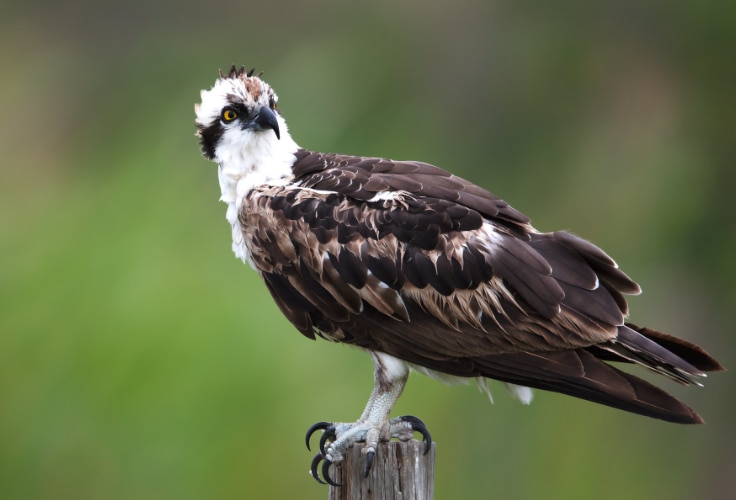
The osprey is a large fish-eating bird, with individuals observed in the UK typically measuring 52-60 centimeters (20.5-23.6 inches) in length, and showing long angled wings that bend sharply at the “wrist,” giving them a gull-like silhouette in flight.
Adults have brown upperparts, clean white underparts, a white head marked by a bold dark eye stripe, and bright yellow eyes, while juveniles are more scaly-looking with buff feather edges and orange eyes. Females are slightly larger and may show a darker brown “necklace” on the chest. When hunting, they soar over lakes or rivers before plunging feet-first into the water, gripping fish with spined talons and carrying their catch headfirst to reduce drag.
In the UK, ospreys are summer visitors, arriving from West Africa around late March and leaving by autumn. Scotland remains their breeding stronghold, particularly around lochs and wetlands in the Highlands, but reintroduction projects have established nesting pairs in Wales and southern England. They are most often seen near large lakes and reservoirs but can also be spotted further south along migration routes.
European Honey Buzzard
Pernis apivorus

The European honey buzzard is a rare summer migrant to the UK, similar in size to a common buzzard, typically measuring 52-60 centimeters (20.5-23.6 inches) in length, but slimmer, with broader wings and a longer tail.
Their plumage is highly variable, ranging from greyish-brown upperparts with whitish underparts to much darker forms, and they often show a barred tail and wings. From a distance they can resemble common buzzards, but honey buzzards have a smaller, dove-like head, a longer neck, and a more buoyant, elastic flight. They feed mainly on the larvae of wasps and bees, often digging into nests on the ground or in trees.
In the UK, they arrive from Africa in late May and depart by September, breeding in secluded mature woodlands, often in upland conifer plantations. They are rare and secretive, with most breeding sites in southern England and scattered pairs in Wales, northern England, and parts of Scotland. Though their numbers remain low, they may have slightly increased in recent decades, likely aided by maturing woodland habitats and better protection.
Montagu’s Harrier
Circus pygargus

Montagu’s harrier is a rare and elegant summer migrant to the UK, smaller than a common buzzard, typically measuring 39-49 centimeters (15.4-19.3 inches) in length. It is slimmer and has more pointed wings than the similar hen harrier, with a long, narrow tail and graceful, buoyant flight.
Males are grey above with black wingtips and a dark stripe across the inner wing, while females and juveniles are dark brown with streaked underparts. This species is easily distinguished in flight by its long, narrow “hand” and agile, gliding hunting style low over fields.
Montagu’s harriers arrive from Africa in late April and leave by September, breeding in only a handful of UK sites, mainly on open arable farmland in southern England such as Wiltshire, though they were once more associated with marshes, making them one of the rarest and most vulnerable summer visitors among UK birds of prey.
Britain lies at the northwestern edge of its European breeding range, so only a few pairs attempt to nest each year, with numbers fluctuating widely and requiring close protection from disturbance and habitat loss.
Rough-Legged Buzzard
Buteo lagopus

The rough-legged buzzard is a scarce winter visitor to the UK, similar in size to a common buzzard but slightly larger, with individuals seen here typically measuring 50-60 centimeters (19.7-23.6 inches) in length.
It has longer wings, a paler head, and a distinctive black-tipped white tail, with a dark belly contrasting against its lighter underparts. In flight it often hovers or “hangs” in the air while hunting, a habit less common in buzzards. A close view also reveals its heavily feathered legs, which give the species its name.
This species breeds in Arctic and sub-Arctic regions from Norway across Eurasia and North America, migrating southwards in autumn. Only a small number reach the UK, arriving mainly on the east coast of England and Scotland, especially the Northern Isles.
Numbers vary widely from year to year depending on food availability in their breeding grounds. They remain strictly winter visitors, with no confirmed UK breeding records despite occasional summer sightings.
Occasional Vagrants
A handful of raptors only visit the UK by chance, appearing as rare vagrants rather than regular migrants.
One of the most famous examples is the snowy owl (Bubo scandiacus), an Arctic species that occasionally drifts south in winter. It bred for eight years on Fetlar in Shetland until 1976 and lingered as a rare breeder in northern Britain into the 1990s, but no nesting attempts have been recorded since 2001. Today, sightings are sporadic and usually confined to remote northern areas such as the Hebrides, Shetland, and the Highlands, where lone birds sometimes linger for a season.
The Eurasian eagle-owl (Bubo bubo) is another enigmatic presence. Occasionally seen and even known to breed in small numbers, these birds are widely believed to originate from escaped or released aviary individuals rather than genuine wild colonisation. Breeding attempts have been noted in northern England, but their true status remains clouded by introductions and the lack of natural range expansion into Britain.
A growing list of rare continental raptors has also made brief appearances. In 2023, the black-winged kite (Elanus caeruleus) was recorded in Montgomeryshire and later East Anglia, reflecting its gradual northward expansion in mainland Europe.
Red-footed falcons (Falco vespertinus) appear irregularly, most often in late spring or autumn, overshooting their central and eastern European breeding grounds during migration.
Equally scarce are short-toed eagles (Circaetus gallicus), occasional wanderers from southern Europe, and the booted eagle (Hieraaetus pennatus), which has caused excitement among birders in Cornwall and Hampshire with a handful of rare sightings in recent years.
While these vagrant raptors are unpredictable and often stay only briefly, their occasional appearances show how shifting weather, migration routes, and expanding ranges can bring unexpected birds of prey to the UK.



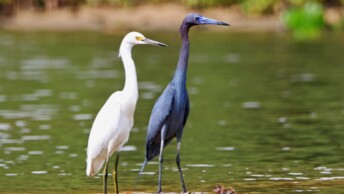
I suspect we have a pair of Merlin’s nesting at the highest point on our land, around 500 m above sea level. They have been around for 30 years. I generally place a largish nest box.
This year the nest structure was very tiny twigs, similar to a those used by a collared dove, with dawn and small bones, maybe from the last meal?
I also know there are long eared owls in the same section where on:
I think Birds are very crucial to our countryside. They play there part in the ecosystem & evolution of nature. Keeping that balance right for reproduction & hunting. They are magnificent creatures which we love to see in the skies. There are some good breeding programs going on in the uk. Which you can be a part of. We need to protect all the wildlife in our nature reserves & beyond. It’s so important to balance the countryside mountains cliffs.